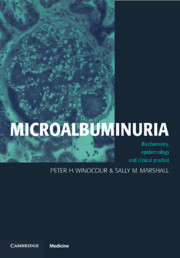Book contents
- Frontmatter
- Contents
- Preface
- Foreword by Professor K. G. M. M. Alberti
- 1 Renal structure and physiology
- 2 Measurement and expression of microalbuminuria
- 3 Epidemiology and determinants of microalbuminuria in health
- 4 Microalbuminuria in diabetes mellitus
- 5 Microalbuminuria as a marker of endothelial dysfunction
- 6 Microalbuminuria, cardiovascular risk factors and cardiovascular disease
- 7 Microalbuminuria as a non-specific marker of disease
- 8 The management of microalbuminuria in diabetes mellitus and essential hypertension
- Index
7 - Microalbuminuria as a non-specific marker of disease
Published online by Cambridge University Press: 06 July 2010
- Frontmatter
- Contents
- Preface
- Foreword by Professor K. G. M. M. Alberti
- 1 Renal structure and physiology
- 2 Measurement and expression of microalbuminuria
- 3 Epidemiology and determinants of microalbuminuria in health
- 4 Microalbuminuria in diabetes mellitus
- 5 Microalbuminuria as a marker of endothelial dysfunction
- 6 Microalbuminuria, cardiovascular risk factors and cardiovascular disease
- 7 Microalbuminuria as a non-specific marker of disease
- 8 The management of microalbuminuria in diabetes mellitus and essential hypertension
- Index
Summary
The pathophysiology of microalbuminuria has focused primarily on its relevance to diabetes, hypertension and cardiovascular disease, but there is increasing interest in the importance of urinary protein excretion in other conditions. Indeed, it is only by awareness of the multiplicity of clinical situations in which microalbuminuria is recorded, that its relatively non-specific nature is apparent. The present chapter identifies those conditions where microalbuminuria has been described and, where relevant, discusses the clinical value in its detection.
Renal disease
Although the presence of microalbuminuria might be thought fundamental to the investigation and monitoring of virtually all non-diabetic renal disease, there is remarkably little written on this subject. It could be anticipated that any structural damage to the glomerular or tubular components of the nephron, or the distal urinary tract, would all be accompanied by microalbuminuria in a large proportion of cases. The additional presence of low molecular weight proteinuria would infer predominantly tubular disease or dysfunction. Albuminuria will accompany any other cause of major overflow proteinuria such as Bence–Jones proteinuria (see later), myoglobinuria or haemoglobinuria. Microalbuminuria as a feature of genito-urinary tract neoplasm has been alluded to earlier in Chapter 6, and has been demonstrated to be of prognostic value in this setting, in both diabetic and elderly subjects. Genito-urinary infection and nephrolithiasis are recognised causes of proteinuria, and microalbuminuria can be expected sometime in the course of events, usually following active treatment, although on occasion as a marker of unexpected structural pathology.
- Type
- Chapter
- Information
- MicroalbuminuriaBiochemistry, Epidemiology and Clinical Practice, pp. 177 - 190Publisher: Cambridge University PressPrint publication year: 1998



